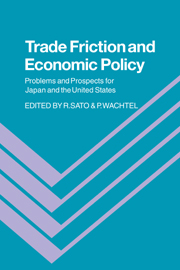Book contents
- Frontmatter
- Contents
- Foreword by Richard R. West
- Preface
- List of contributors
- 1 Introduction
- Part I Sources of trade friction
- Part II Macroeconomic policy
- 6 The U.S. and Japanese economies in the remaining Reagan years
- 7 U.S. macroeconomic policy and trade relations with Japan
- 8 New financial aspects of the U.S.–Japanese trade relationship
- 9 Japanese–U.S. current accounts and exchange rates before and after the G5 agreement
- Part III Trade policy
- Index
9 - Japanese–U.S. current accounts and exchange rates before and after the G5 agreement
Published online by Cambridge University Press: 05 February 2012
- Frontmatter
- Contents
- Foreword by Richard R. West
- Preface
- List of contributors
- 1 Introduction
- Part I Sources of trade friction
- Part II Macroeconomic policy
- 6 The U.S. and Japanese economies in the remaining Reagan years
- 7 U.S. macroeconomic policy and trade relations with Japan
- 8 New financial aspects of the U.S.–Japanese trade relationship
- 9 Japanese–U.S. current accounts and exchange rates before and after the G5 agreement
- Part III Trade policy
- Index
Summary
The world economy has been greatly influenced over the past 10 years by the monetary and fiscal policies of the industrialized nations. Looking back at U.S. economic policy in particular, we see that expansionary monetary policy kept inflation at a high level over the latter half of the 1970s. It was with the aim of curbing this inflation that tight monetary policy was brought into play over the period 1979–82. This restrictive monetary policy, which brought about recession not only in the U.S. but throughout the world, was clearly successful in the sense that it managed to reduce the rate of inflation.
With monetary policy being eased after 1982, large-scale expansionary fiscal policy, including various tax cuts, was implemented. This resulted in an increase in fiscal and trade deficits, high interest rates, a d a strong dollar.
The rising fiscal and trade deficits, in turn, shifted economists' attention to studying the effects of fiscal policy in an open economy context. These studies suggest that the largest factor behind the U.S. current account deficit (or the Japanese current account surplus) is the increase in the U.S. fiscal deficit. As a result, it has become apparent that the U.S. fiscal deficit must be reduced and that Japan must pursue expansionary fiscal policy if the U.S.–Japanese trade imbalance is to decline.
In an attempt to resolve their trade imbalance, the United States and Japan held the historic G5 meeting. While the participants at that meeting recognized the need for the directions in fiscal policy outlined above, political realities suggested that the implementation of such policies would not be easy.
- Type
- Chapter
- Information
- Trade Friction and Economic PolicyProblems and Prospects for Japan and the United States, pp. 127 - 156Publisher: Cambridge University PressPrint publication year: 1987



